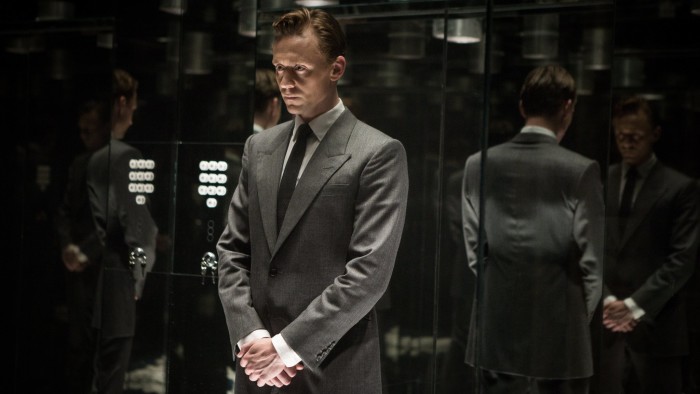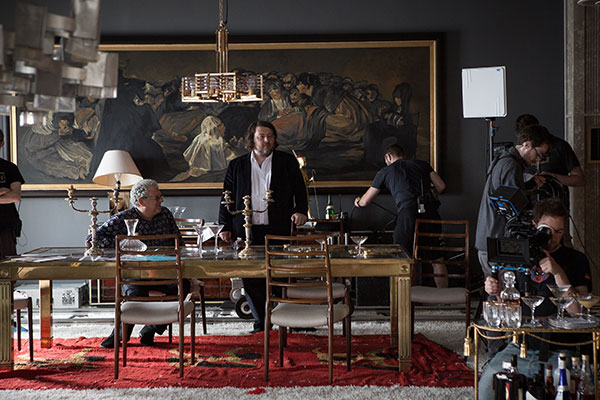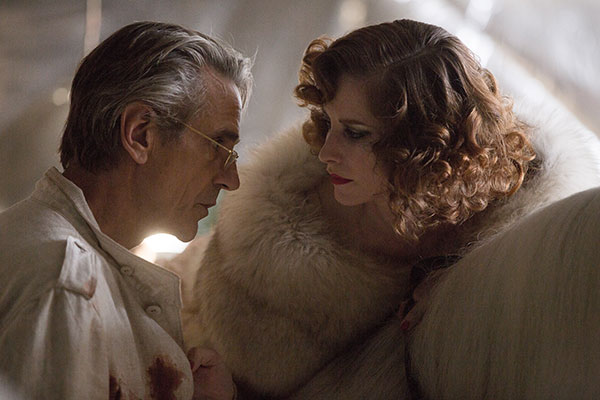‘High-Rise’: vertical battleground of class warfare

Roula Khalaf, Editor of the FT, selects her favourite stories in this weekly newsletter.
“THE WAR OF THE JUNGLE” screams a front-page headline on the day I’m due to meet British film director Ben Wheatley. The accompanying image is of a man silhouetted in front of a burning building — a migrant at a Calais refugee camp, it turns out — but above him the newspaper’s skyline cheerfully announces a London property pull-out, complete with ads for a series of gleaming new tower blocks on the Thames.
Either one of these images, or even the jarring juxtaposition, could be taken straight from Wheatley’s new film High-Rise, an adaptation of JG Ballard’s 1975 novel. In it, Tom Hiddleston stars as the sharp-suited, proto-yuppie-ish Dr Laing, a cool, detached type who, sometime in the late 1970s, moves into a state-of-the-art Thames-side edifice and begins a flirtation with his neighbour, socialite single mother Charlotte (Sienna Miller).
While the upper echelons, led by the building’s architect, Royal (Jeremy Irons), throw decadent costume parties and ride horses on the roof terrace, the lower floors suffer power cuts and swill supermarket booze, prompting the documentary-maker-cum-rabble-rouser Wilder (Luke Evans) to launch upward skirmishes. Laing, somewhere in the middle, watches as the building becomes a vertical battleground of class warfare.
It may sound grim but the film is anything but. Wheatley, with the considerable input of his writing partner (and wife) Amy Jump, has forged a reputation as one of Britain’s most singular film-makers with Kill List (2011), Sightseers (2012) and A Field in England (2013), and one of the hallmarks of their work is the way it combines the nightmarish with the blackly comic. While Jump has adapted Ballard’s book in faithful detail, she has foregrounded the dark humour that in the novel is often only lurking in the shadows.
Wheatley, who was born in 1972 and grew up in Essex and London, says that what struck him on rereading the novel was how much now rang true: “I’d enjoyed it when I was a teenager for the anarchy and the violence and the sex and stuff . . . But when I came back to it as a 40-year-old with a kid, it was a very different experience . . . At the time it was ‘this might happen’, but now it has happened, this idea of the rich removing themselves from the dirt of the city, escaping from the poor and isolating themselves.”
Ballard, the doyen of dystopian fiction, is often held up for his prescience, and High-Rise is no exception. Some of the details in the novel seem strikingly up-to-date: residents who roam the hallways filming the carnage for “dubious private newsreels” and welcome “the invasion of their privacy by government agencies and data-processing organisations”. But if the book is so relevant to today’s world, why not just set it now?
“I think that was what everybody else had tried to do with their adaptations of it, and completely reasonably,” Wheatley says, referring to the several scripts that British producer Jeremy Thomas had commissioned since picking up the rights almost 30 years ago. “But as you get further away from the book, you hit certain things that change and break it.”
The result is a film that is as much about the time in which it is set as it is about now. “The rather convoluted way of looking at it I’ve had is that the book is in the past, but it’s projecting into the future,” Wheatley says. “We are in the far future, looking to the past. The film is a period piece which is also a sci-fi film. It’s in the past and in the future simultaneously.”
If that wasn’t brain-scrambling enough, he added a further dimension by not only setting it in the 1970s but making it in the style of a 1970s film. Anyone who knows the movies of that period will be transported back to the cinematic world of Nic Roeg (who at one time came close to making High-Rise himself) and Ken Russell, particularly in the film’s lurid latter part in which the montages grow increasingly feverish and we are served tableaux of orgiastic abandon. (To top it all, Luke Evans’ Wilder, barrel-chested and amply moustached, looks like Oliver Reed reanimated.)

But there is an uglier side to the 1970s setting in the story’s sexual politics, especially given the recent string of revelations about public figures from the era. It’s hard not to wince at lines such as “he’s raping people he isn’t supposed to”, even if they are dripping with deadpan irony. None of the men comes out of it well — nor even does the Financial Times, a copy of which makes a cameo appearance not just as a signifier of status and privilege but as an offensive weapon. “The past is the past, man; it’s a different world now,” Wheatley offers.
Does he think we live in a more moral age now? “No, I’ll completely contradict myself, but I don’t think so, no. I think it’s much the same . . . I imagine us 60 years in the future, looking back at this period and going, [winces] ‘ooh’ . . . ”
Things may not be looking any better for the world but they are looking ever better for Wheatley these days. After studying fine art he learnt his craft by making short films and then picking up TV work. He made his first feature, Down Terrace, for £6,000 in 2009. Now, with a string of critical and commercial successes behind him, he has made a film featuring A-List stars and a still-modest budget of £5m (“literally just crawling into low-budget”). And there are some plum projects in the pipeline, not least a sci-fi TV series he is developing for HBO called Silk Road and a remake of Clouzot’s classic The Wages of Fear, which he is halfway through scripting.

But more imminent is Free Fire, to which Wheatley is currently putting the finishing touches, and which stars Brie Larson, who was awarded the Best Actress Oscar only the day before we meet. The win is sure to boost the fortunes of Free Fire, in which Larson plays a go-between for two Irishmen (Cillian Murphy and Michael Smiley), who come to Boston in the 1970s to buy guns for the IRA. “It came out of this idea that the spectacle of violence in cinema has got bigger and bigger, and yet becomes less and less engaging for me,” says Wheatley, who promises “a quasi-realistic look at what a gunfight might be like at close quarters”.
If Hollywood comes calling, is Wheatley open to the idea of taking on a potential blockbuster? “If it’s the right thing, then I’d definitely do it . . . But it wouldn’t necessarily be where I’d want to be forever after that, so I’d come back to the same way that we did A Field in England . . . or even Down Terrace, because we did whatever we wanted, and there was no risk. The film can just about make its money back, and it can be really weird and interesting.”
Wheatley may soon be propelled to the upper echelons of the movie business but where would he fit into the high-rise? It’s a question that many who read the book feel compelled to ask themselves. “I’m at the bottom, obviously,” he says. “All the media people are the scum at the bottom . . . I’m not as erudite and sharp as Hiddleston — he deserves his place in the middle — and I’m certainly not at the dizzy heights of Irons.”
I show Wheatley my newspaper with its twin images of civil unrest and upscale high-rises. “Yes, that’s Ballard, isn’t it? Straight there.” But, he observes, the worst may be yet to come. “It’s thoroughly depressing that Ballard’s getting it so right. And it makes me worry — because the later books are really dystopian.”
‘High-Rise’ is released in the UK on March 18 and in the US on May 13
Photographs: Aidan Monaghan
Comments